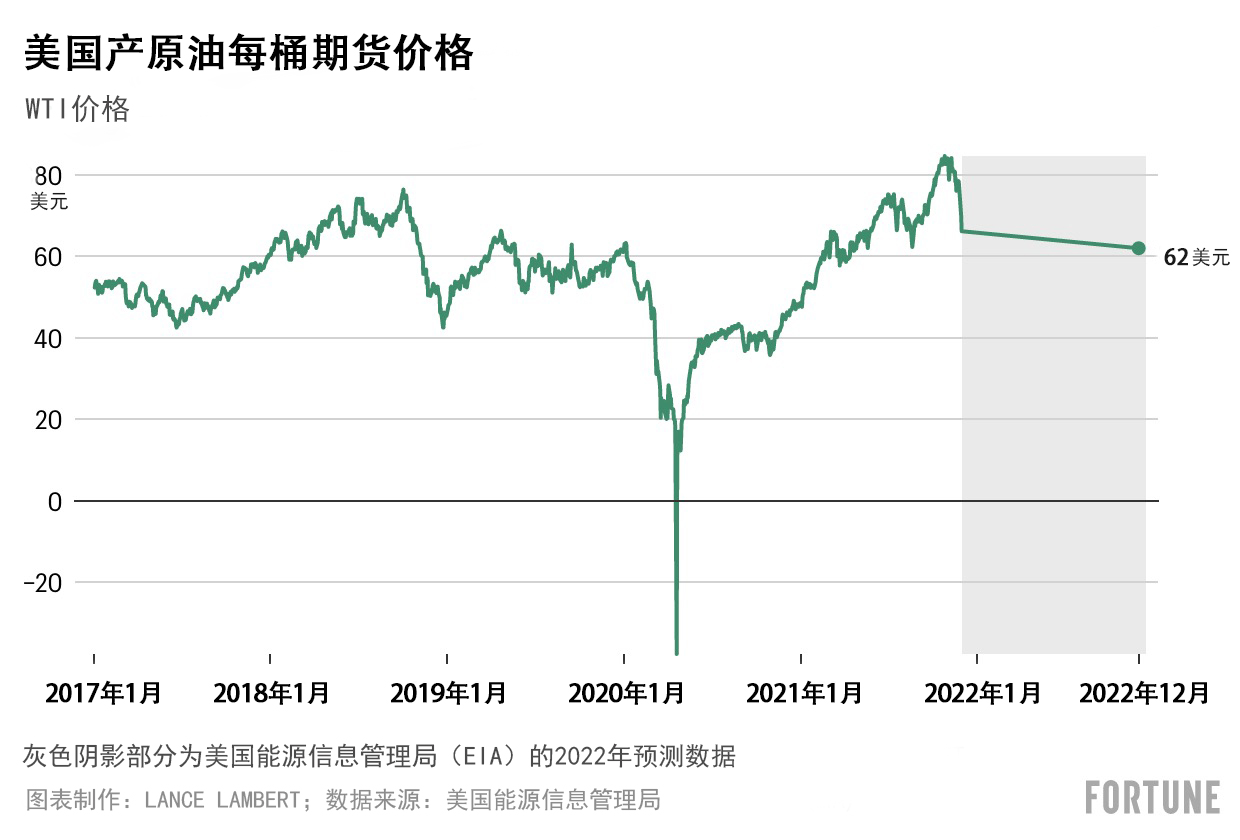2020年新冠疫情导致全球交通封锁,使航空和邮轮出行几乎停滞,日常办公通勤频次大减,导致全球对石油的需求几近降至冰点。虽然此后原油供应增加,但储存场所却十分缺乏,最终导致美国国内原油期货价格于2020年4月陡然跌为负数。油价最低时,西得克萨斯中质油(WTI)合约价为负,即每卖一桶油,卖家还得倒找37美元给买家。
然而最近的情况却开始倒转,油价不仅出现了反弹,而且涨得比疫情爆发前还高。随着史无前例的快速经济复苏,对石油的需求迅速回升,比预期还要强劲。去年油价暴跌,产油国除减产外别无他法,因而库存稀少,被暴增的需求迅速耗尽。截至上周五,WTI合约价格为每桶69.62美元,较2020年12月上涨了52%。这也导致了汽油价格的上涨。美国汽油常规均价为每加仑3.34美元,自2020年12月以来上涨了55%。
2022年的燃料价格走势将会是怎样的?为了找到答案,《财富》杂志对几个权威的预测模型进行了盘点。
主要结论:尽管美国政府预测,2022年石油和天然气价格都将下降,但相关私营领域的多个预测都显示,燃料价格会继续上升。

高盛(Goldman Sachs)认同巴克莱银行的看法。高盛的石油分析师认为油价存在“上行风险”,目前欧洲海岸开采的布伦特原油合约价格为每桶73美元,2023年可能会攀升至85美元。
但美国能源信息管理局(EIA)并不同意这一观点,并持相反态度(见上图)。其预测,到2022年底,WTI和布伦特原油合约价将分别降至每桶62美元和66美元,原因在于原油供需不匹配的状况将在明年得到缓解。
EIA的研究人员在2022年的展望报告中写道:“我们预测,2022年欧佩克+和美国的原油产量上升,全球液态燃料库存增加,原油价格随之下跌。”“全球范围内、美国国内的原油库存近期相对较低,使原油合约价格面对上涨的压力。然而,长期原油合约价格较低,这可能反映出,市场将会更加平衡。”

当然,所有预测模型都是建立在假设的基础上的,而这些假设很容易出现错误。如果明年欧佩克及其盟友国不按原计划扩大石油生产,才会产生最大的风险。(财富中文网)
译者:Transn
2020年新冠疫情导致全球交通封锁,使航空和邮轮出行几乎停滞,日常办公通勤频次大减,导致全球对石油的需求几近降至冰点。虽然此后原油供应增加,但储存场所却十分缺乏,最终导致美国国内原油期货价格于2020年4月陡然跌为负数。油价最低时,西得克萨斯中质油(WTI)合约价为负,即每卖一桶油,卖家还得倒找37美元给买家。
然而最近的情况却开始倒转,油价不仅出现了反弹,而且涨得比疫情爆发前还高。随着史无前例的快速经济复苏,对石油的需求迅速回升,比预期还要强劲。去年油价暴跌,产油国除减产外别无他法,因而库存稀少,被暴增的需求迅速耗尽。截至上周五,WTI合约价格为每桶69.62美元,较2020年12月上涨了52%。这也导致了汽油价格的上涨。美国汽油常规均价为每加仑3.34美元,自2020年12月以来上涨了55%。
2022年的燃料价格走势将会是怎样的?为了找到答案,《财富》杂志对几个权威的预测模型进行了盘点。
主要结论:尽管美国政府预测,2022年石油和天然气价格都将下降,但相关私营领域的多个预测都显示,燃料价格会继续上升。
巴克莱银行(Barclays)预测, 2022年,WTI合约价格将从目前的每桶69.62美元上涨到77美元。该银行表示,拜登政府最近动用石油战略储备来降低油价,这并不是一种可持续发展的方式,而且最近几周的油价回落“只是暂时的”。世界银行表示,如果新冠疫情产生的影响达到最小化,石油需求的增长会超过预期,那么油价也可能会高于预期。简单地说:如果明年疫情逐渐平息,油价就可能会遭受更大的上涨压力。
高盛(Goldman Sachs)认同巴克莱银行的看法。高盛的石油分析师认为油价存在“上行风险”,目前欧洲海岸开采的布伦特原油合约价格为每桶73美元,2023年可能会攀升至85美元。
但美国能源信息管理局(EIA)并不同意这一观点,并持相反态度(见上图)。其预测,到2022年底,WTI和布伦特原油合约价将分别降至每桶62美元和66美元,原因在于原油供需不匹配的状况将在明年得到缓解。
EIA的研究人员在2022年的展望报告中写道:“我们预测,2022年欧佩克+和美国的原油产量上升,全球液态燃料库存增加,原油价格随之下跌。”“全球范围内、美国国内的原油库存近期相对较低,使原油合约价格面对上涨的压力。然而,长期原油合约价格较低,这可能反映出,市场将会更加平衡。”
根据EIA的预测,如果原油价格大幅下跌,加油站的汽油价格也会随之下降。预计到明年1月,汽油均价(现每加仑3.34美元)将降至3.01美元。EIA预计,2022年美国常规汽油和柴油均价分别为每加仑2.88美元和3.19美元。
当然,所有预测模型都是建立在假设的基础上的,而这些假设很容易出现错误。如果明年欧佩克及其盟友国不按原计划扩大石油生产,才会产生最大的风险。(财富中文网)
译者:Transn
Demand for petroleum absolutely crashed at the onset of the 2020 lockdowns as air travel, cruise trips, and daily office commutes evaporated. The ensuing buildup in crude oil supply—and the lack of places to store it—culminated in the futures price of domestically produced crude briefly going negative in April 2020. At the bottom of the crash, sellers of West Texas Intermediate (WTI) contracts were paying buyers $37 per barrel to take their oil.
Lately we've had the opposite problem: Not only did oil prices rebound, they're higher now than prior to the pandemic. When oil prices crashed last year, producers had no choice but to cut production. That reduced supply was quickly outmatched as the historic economic recovery saw demand roar back sooner—and stronger—than expected. As of Friday, that WTI contract price stands at $69.62 per barrel—up 52% from December 2020. That has also translated into higher prices at the pump. The average U.S. regular price of $3.34 per gallon is up 55% since December 2020.
But where are oil and gas prices headed in 2022? To get an indication, Fortune reviewed several leading forecast models.
The big takeaway: While U.S. government forecasts predict both oil and gas prices will see a decline in 2022, many private sector forecasts show the opposite occurring.
When it comes to domestically produced crude, Barclays predicts that the WTI contract price will increase from the current rate of $69.62 to an average price of $77 in 2022. The bank says the Biden administration's recent release of oil from the Strategic Petroleum Reserve isn't a sustainable way to bring down prices, and the dip we've seen in recent weeks "would only be temporary." Prices could go even higher than forecast, the bank says, if COVID-19 outbreaks are minimized and thus allow demand to grow by more than expected. Simply put: If the pandemic winds down next year, that could put more upward pressure on prices.
That assessment is shared by Goldman Sachs. Oil analysts at the investment bank see "upside risks" that contract prices for Brent crude—oil drilled off the shore of Europe—could climb from the current price of $73 to $85 per barrel by 2023.
But the U.S. Energy Information Administration (EIA) doesn't agree. Instead, the government agency is predicting (see chart above) that the WTI price per barrel will drop to $62 by the end of 2022, and Brent oil contracts will fall to $66 per barrel. The reason? EIA says the supply and demand mismatch for crude will ease in 2022.
"We forecast that rising production from OPEC+ countries and the United States will lead to global liquid fuels inventories increasing and crude oil prices falling in 2022," wrote EIA researchers in their 2022 outlook. "Low crude oil inventories, both globally and in the United States, have put upward price pressure on near-dated crude oil contracts, whereas longer-dated crude oil contract prices are lower, likely reflecting expectations of a more balanced market."
If crude prices do fall significantly, it would translate into lower gasoline costs at the pump. That's exactly what EIA is predicting. By January, it forecasts that average gasoline prices (currently at $3.34) will drop to $3.01 per gallon. For the 2022 calendar year, it expects regular U.S. gasoline prices to average $2.88 and diesel to average $3.19 per gallon.
Of course, all of these models are built on assumptions that could easily go astray. The biggest risk? That OPEC and its allies don't follow through on their 2022 plan to up production.






